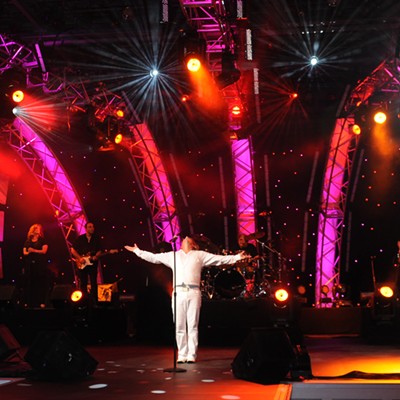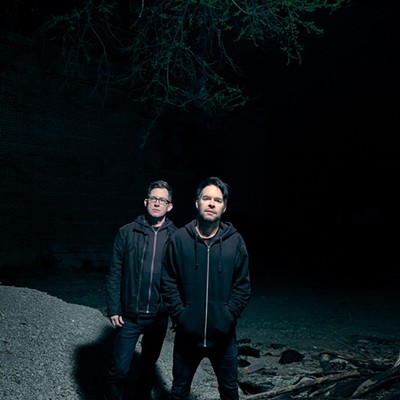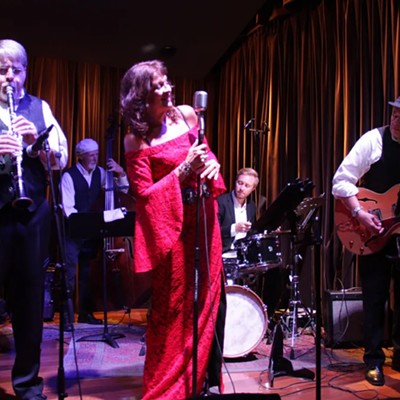Sergio Mendoza y la Orkesta, a Latin-jazz big band now just reaching the age of six months, came together as an ad-hoc group to play The Great Cover-Up. However, it has grown to become an increasingly popular draw in Tucson nightclubs and around the Southwest.
"We were definitely a Cover-Up thing," says bandleader and composer Mendoza, who sings and plays keyboards. "But we decided to carry on after that."
The Great Cover-Up, as astute readers of the Tucson Weekly know, is an annual three-night event at Club Congress. Local acts perform tributes to the music of specific artists; it's been happening for 11 years, and the proceeds benefit worthy charities.
Forming around musicians with experience in the alternative-rock band The Jons and the jazz-funk group Seven to Blue, the Orkesta gathered to cover the work of mambo legend Pérez Prado.
The Orkesta's set was so successful that the band decided to continue beyond the Cover-Up, and their first official gig was opening for Calexico on Dec. 29, 2008, at the Rialto. Since then, Mendoza and company have benefited from the alliance with that influential local group.
"The guys in Calexico have been very helpful," Mendoza says. "They're the nicest group of people we have ever met. We did four shows with Calexico pretty close to each other, in Phoenix, Flagstaff and two in Tucson, and they have really helped us gain a following."
The Orkesta's following is such that, even so early into its career, the group can draw more than 230 people to a gig at $10 a head. Such stats cause Mendoza to marvel: "We're very lucky that so many people are interested in what we do."
And Tucson's lucky, too. In a relatively short period of time, Sergio Mendoza y la Orkesta have become one of our town's most exciting live acts. The group will headline a concert on Saturday, June 27, at the Rialto Theatre. Also on the bill will be Rafael Moreno y Descarga and Caray.
The Orkesta includes 12 regular members (and its ranks grow beyond that occasionally), drawing talent from local acts such as Latino Solido, Manteca and Mostly Bears. Another important member is visual artist Salvador Duran, who sings and plays percussion; he, too, has spent time playing with Calexico over the years.
Mendoza and Duran spoke to me while retreating from the oppressive summer heat with glasses of cool water in Duran's Warehouse District art studio, where he has given over part of the space to Mendoza's recording studio.
Although Mendoza is 28 years old, and Duran is 59, they share a kinship and love of classic Latin-jazz music, especially the big groups of the 1940s and '50s.
As it happens, both arrived in Tucson in 2000, but they'd never met until they teamed up in the Orkesta. Mendoza grew up in Nogales, Ariz., where he played in his high school Dixieland jazz band, and Duran is originally from the town of Cananea, in Sonora.
Mendoza says his collaboration with Duran is no longer just about the music. "It's also about the friendship, the stories, the long nights of making music."
Duran brought to the partnership a knowledge of old-school mambo, cumbia, Latin swing and other traditional forms; Mendoza infused his interest in that music with the funky jangle of alternative rock.
With the Orkesta, Duran also performs nonverbal, percussive vocalizations, which have become one of his trademarks; in a different context, it might sound like jazz scatting. "But we're using it more like a psychedelic effect. Our sound guy uses effects to experiment with it," Mendoza points out.
Ever the artist, Duran uses metaphors to describe the nature of the Orkesta's approach to music.
"Now, these days, it's all about recycling everything, including music," Duran says. "When you recycle, you take the good parts of what has been around, and you use them to make something new, with new feelings."
In that spirit, the band has moved from doing all covers—such as Prado's immortal "Mambo No. 8" or the Latin standard "Bésame Mucho"—to sprinkling them throughout a set of predominantly original music.
Duran also says that music, especially that of the Orkesta, must be organic to be successful.
"It's organic when it grows naturally: You feel it, and you don't think it out too much in advance. There's an exchange that happens with the audience while they are listening," he says, adding that such an exchange enriches both player and listener.
Mendoza and Duran work hard to make each Orkesta gig a real show, pulling out all the stops: They have a traditional bandstand and dinner jackets for all the members. But the logistics of scheduling, attiring and moving a dozen or more musicians around can be challenging.
"It's tough; it's rough, but we're all doing it because it's worth it," Mendoza says. "We have a lot of fun, and that's a huge part of it. From the enthusiastic responses we get, that must be rubbing off on the audiences."
Sergio Mendoza y la Orkesta recently released a live CD that they are selling at gigs, and will soon begin work on a studio disc, to be produced by Calexico's Joey Burns, that they expect to release in 2010—the same year they are planning a European concert tour.
As the interview winds down, hearty abrazos are exchanged, and outside, twilight begins to roll mercifully across sun-baked Tucson, causing Mendoza to muse: "Time to play music."







